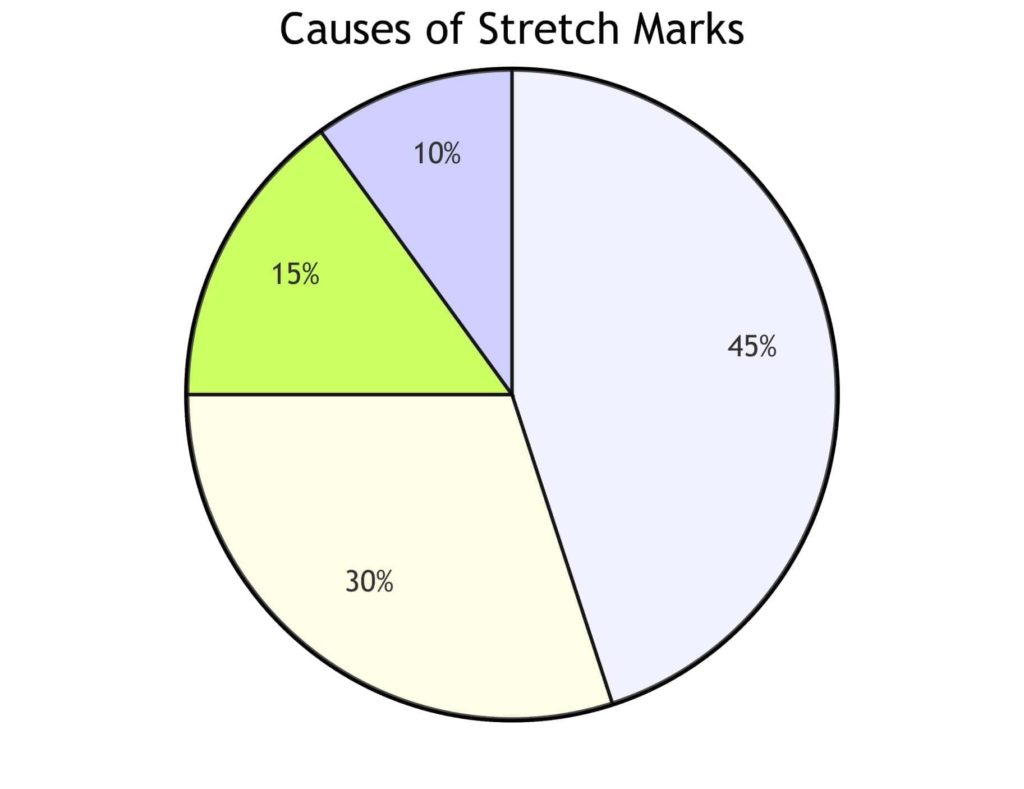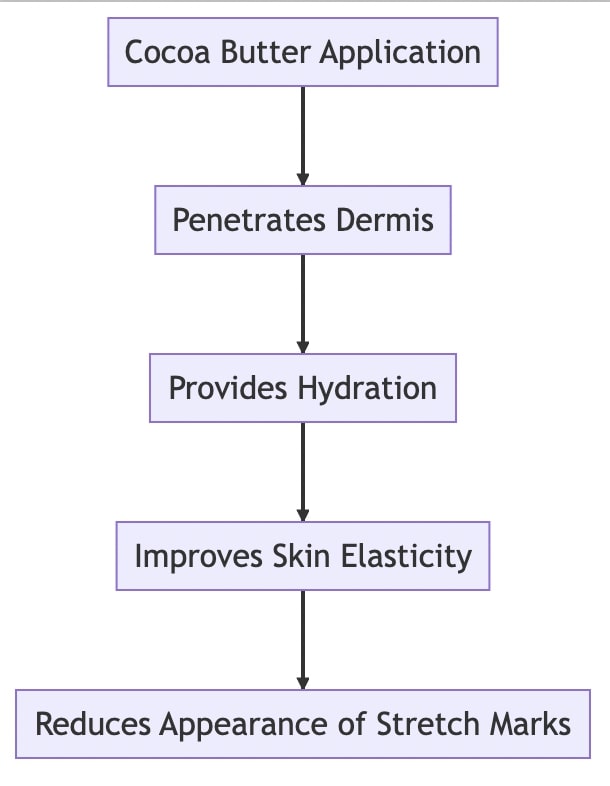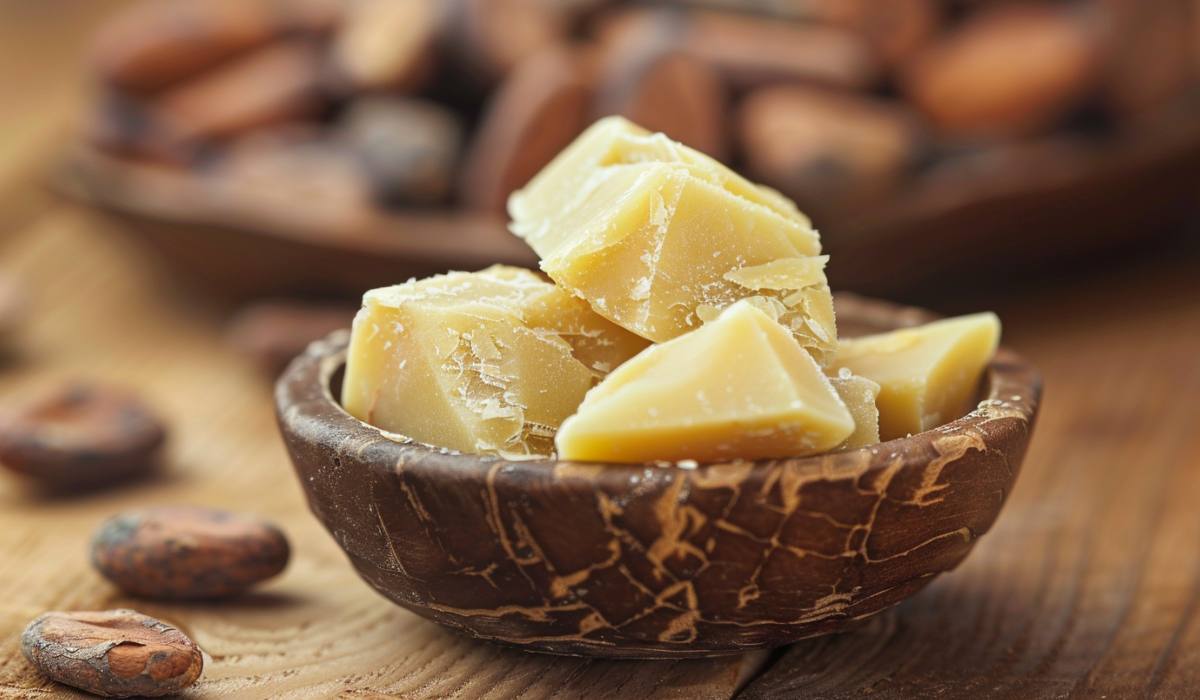Cocoa Butter and Stretch Marks: the Science Behind
Cocoa butter and stretch marks: can cocoa butter help fade the marks?
Are you tired of living with stretch marks and ready to explore potential solutions?
Cocoa butter, known for its potent moisturizing properties, is often recommended as an aid in reducing stretch marks.
This comprehensive guide will delve into the science behind how cocoa butter may help decrease the appearance of stretch marks. Time to unwrap this exotic remedy together.
Cocoa Butter and Stretch Marks – Key Takeaways
- Cocoa butter has moisturizing properties that can penetrate deep into the dermis, potentially improving skin elasticity and fading stretch marks over time.
- While research shows that cocoa butter alone may not completely eliminate stretch marks, regular use of cocoa butter can contribute to a smoother complexion and enhance overall skin texture.
- Other moisturizers like almond oil and olive oil have not been found to prevent or fade stretch marks effectively. Cocoa butter stands out because it can deeply penetrate the skin’s dermis and provide intense hydration.
Author Expertise: I’m Patri Hernandez, a certified dermo-cosmetic technician and health coach. I blend my love for skincare with holistic wellness insights. My goal? To help you achieve radiant skin and a happier, healthier you! 😊 Patri Hernandez
Understanding Stretch Marks
Stretch marks are a common skin concern that occur when the skin is stretched rapidly beyond its normal limits, resulting in fine lines or streaks.
What are stretch marks?
Stretch marks are a common skin ailment that many of us encounter. They appear as streaky, thin lines or scars on the body’s surface and can fluctuate in color, from red to purple and eventually fading to a lighter hue.
They most frequently occur due to sudden changes in the body size such as during pregnancy, rapid weight gain or loss, growth spurts in adolescence or sometimes they may be linked with certain health conditions.
This skin alteration happens when our skin stretches quicker than its capacity to regenerate itself causing minor tears within the dermis – the second layer of our skin – disrupting collagen production.
The visible ripples we identify as stretch marks are essentially scar tissue formed by these disruptions underneath the skin’s surface.

- Pregnancy: 45%
- Weight Gain: 30%
- Growth Spurts: 15%
- Other Factors: 10%
How do the stretch marks form?
Stretch marks form when the skin stretches or shrinks rapidly, causing the collagen and elastin fibers in the dermis to break. This can happen during pregnancy, growth spurts, or rapid weight gain or loss.
When these fibers tear, it creates visible lines on the skin’s surface known as stretch marks. The body tries to repair these tears by producing new collagen fibers, but they often appear as discolored scars that are difficult to completely eliminate without intervention.

Why do stretch marks take time to heal?
Stretch marks take time to heal because they occur deep within the skin’s layers. When the body experiences rapid growth or weight gain, such as during pregnancy or puberty, the skin stretches quickly and causes damage to the elastin fibers in the dermis.
This results in stretch marks appearing on the surface of the skin.
The healing process for stretch marks involves repairing and rebuilding these damaged fibers, which takes time. The body needs to produce new collagen, a protein responsible for providing strength and structure to the skin.
As new collagen is formed, it gradually replaces the damaged tissue and helps fade and smooth out stretch marks.
It’s important to note that everyone’s healing process is different, so while some individuals may notice their stretch marks fading over a few months, others may take longer depending on factors like genetics, age, and overall skin health.
Are there Benefits of Cocoa Butter for Stretch Marks?
Cocoa butter may help reduce the appearance of stretch marks by penetrating deep into the dermis, providing intense hydration and improving skin elasticity.
How cocoa butter helps with stretch marks
Cocoa butter is often touted as helpful in reducing the appearance of stretch marks. While research shows that cocoa butter alone may not completely eliminate stretch marks, (see references below) it does offer some benefits in improving their visibility.
Cocoa butter has the ability to penetrate deep into the dermis, rather than just sitting on the surface of the skin like other moisturizers. This allows it to hydrate and nourish the skin from within, potentially helping to improve elasticity and fade stretch marks over time.
Additionally, cocoa butter contains antioxidants that can support the skin’s healing process and reduce inflammation, further aiding in minimizing the appearance of these marks. Regular use of cocoa butter can help enhance overall skin texture and maintain its moisture levels, contributing to a smoother complexion even with stretch marks present.
Here’s a flowchart illustrating the process of how cocoa butter works on the skin to reduce the appearance of stretch marks:

- Cocoa Butter Application: The initial step where cocoa butter is applied to the skin.
- Penetrates Dermis: Cocoa butter penetrates the deeper layers of the skin.
- Provides Hydration: It offers hydration to the skin.
- Improves Skin Elasticity: The hydration improves the skin’s elasticity.
- Reduces Appearance of Stretch Marks: Over time, this can lead to a reduction in the visibility of stretch marks.
Research on the effectiveness of cocoa butter
Cocoa butter’s effectiveness in reducing the appearance of stretch marks has been a topic of interest and research. Here’s what the studies tell us:
| Study Findings | Impact on Stretch Marks |
|---|---|
| Regular application of cocoa butter does not significantly reduce stretch marks, says research. | Although cocoa butter moisturizes the skin, its use does not guarantee the disappearance of stretch marks. |
| Cocoa butter penetrates into the dermis, the second layer of skin. | This deep reach of cocoa butter may help lessen the appearance of stretch marks by improving skin elasticity. |
| Antioxidants in cocoa butter support the skin’s healing process and reduce inflammation. | Inflammation reduction might aid in the overall healing process of stretch marks, making them less noticeable. |
| Research indicates that remedies such as almond oil, olive oil, and cocoa butter do not effectively prevent or fade stretch marks. | The effectiveness of cocoa butter in completely preventing or fading stretch marks is not proven scientifically. |
The consistent use of cocoa butter can help retain skin elasticity and prevent dryness. These properties may contribute to a healthier appearance of the skin, including areas with stretch marks. However, the perception that cocoa butter can outright prevent or eliminate stretch marks is not supported by current scientific research.
Other moisturizers compared to cocoa butter
There are several moisturizers on the market that claim to reduce stretch marks, but how do they compare to cocoa butter?
While other moisturizers like almond oil and olive oil are often touted as remedies for stretch marks, studies have found that they don’t effectively prevent or fade them.
Cocoa butter stands out because of its ability to deeply penetrate the skin’s dermis, not just the surface layer.
Additionally, cocoa butter has hydrating properties that can deeply moisturize the skin and improve elasticity, potentially reducing the visibility of stretch marks.
It’s no wonder why cocoa butter is commonly used in skincare products due to its nourishing and emollient benefits.
The Debate
While cocoa butter has long been believed to be effective in reducing stretch marks, current research suggests this is inconclusive.
Although it can moisturize the skin and improve elasticity, there is no scientific evidence that cocoa butter directly fades or prevents stretch marks.
Here are some helpful links on this:
- Cleveland Clinic: The Cleveland Clinic mentions that cocoa butter, also known as theobroma oil, has not been proven to be better (or worse) than placebos in preventing stretch marks. The article mentions other helpful remedies although I always prefer natural ones.
- The Mommy’s Coach: An article from The Mommy’s Coach discusses the comparison between shea butter and cocoa butter for stretch marks. It suggests that while shea butter might be beneficial, cocoa butter’s effectiveness is still debated.
- The New York Times: An article titled “The Claim: Cocoa Butter Can Remove Stretch Marks” likely delves into the claim and its validity.
- Palmer’s: Palmer’s, a brand known for its cocoa butter products, has a product specifically formulated as Cocoa Butter for Pregnancy Stretch Marks + Scars. They claim that their product helps reduce the appearance of stretch marks while improving skin elasticity.
- The Spoiled Mama: An article titled “Cocoa Butter for Stretch Marks: Why we love it” likely discusses the benefits of cocoa butter for stretch marks.
From the search results, it appears that the effectiveness of cocoa butter in preventing or reducing stretch marks is still a debated topic.
While some sources and brands advocate for its benefits, others, like the Cleveland Clinic, suggest that it might not be more effective than a placebo.
It is essential to consider individual experiences and consult with a dermatologist or skincare expert for personalized advice.
Ultimately, when it comes to choices that impact your life, you have to decide for yourself.
Below you will find a section on how to use cocoa butter for stretch marks if you decide to give it a try.
How to Apply Cocoa Butter for Stretch Marks Effectively
To effectively use cocoa butter for stretch marks, gently massage a small amount onto the affected area in circular motions until fully absorbed.
Apply twice daily for optimal results.
Proper application techniques
To effectively reduce the appearance of stretch marks with cocoa butter, it’s important to follow proper application techniques. Here are some guidelines to help you make the most out of your cocoa butter treatment:
- Start with clean, dry skin. Before applying cocoa butter, make sure your skin is free from any dirt, oil, or sweat. Cleanse the area thoroughly and pat it dry with a towel.
- Warm up the cocoa butter. Cocoa butter has a solid consistency at room temperature, so it’s best to warm it up slightly before applying. You can do this by rubbing a small amount between your palms until it melts or by using a microwave for a few seconds.
- Massage gently into the skin. Take a small amount of warmed-up cocoa butter and start massaging it onto the affected area in circular motions. Apply enough pressure to ensure that the cocoa butter penetrates the dermis.
- Focus on problem areas. If you have specific areas where stretch marks are more prominent, concentrate your efforts on those spots during application. This will help target those areas and improve their appearance over time.
- Apply twice daily for best results. For optimal results, apply cocoa butter to your stretch marks at least twice a day – once in the morning and once at night before bed. Consistency is key when using any skincare product.
- Be patient and consistent with usage. It’s important to note that reducing stretch marks takes time and consistent effort. Don’t expect overnight results, but instead commit to regular use of cocoa butter for an extended period to see improvements in the appearance of your stretch marks.
Frequency of use
To see the potential benefits of cocoa butter on stretch marks, it’s important to use it consistently. Applying cocoa butter regularly can help moisturize and improve the elasticity of your skin, which may reduce the visibility of stretch marks over time.
While there is no specific guideline on how often you should use cocoa butter, applying it at least once or twice a day can be beneficial. Remember that consistency is key when trying to fade stretch marks with any skincare product.
Be patient and give your skin enough time to absorb the nourishing properties of cocoa butter for optimal results.
Potential risks and warnings
It’s important to note that while cocoa butter is generally considered safe for use on the skin, there are potential risks and warnings to be aware of. Some individuals may be allergic to cocoa butter, so it is recommended to do a patch test before applying it all over the affected area.
If the stretch mark is on your face or other acne-prone skin area, cocoa butter may not be suitable for you as it can clog pores and potentially lead to breakouts.
It’s always best to consult with a dermatologist before starting any new skincare regimen.
Cocoa Butter and Stretch Marks Forum Threads
Explore the threads to gain insights and read about personal experiences related to the use of cocoa butter for stretch marks:
- Stretch marks and palmers cocoa butter – Bodybuilding.com Forums
- A discussion on the Bodybuilding.com forum about the effectiveness of Palmer’s cocoa butter in addressing stretch marks.
- Stretchmark Cream without cocoa butter? — The Bump
- A thread on The Bump forum where users discuss alternatives to cocoa butter for stretch marks.
Conclusion
Cocoa butter is often recommended for its potential benefits in reducing the appearance of stretch marks due to its deep moisturizing properties. While it can penetrate the dermis and provide hydration, improving skin elasticity, current research suggests that cocoa butter alone may not completely eliminate stretch marks.
However, its consistent use can contribute to a smoother skin texture. Other moisturizers, such as almond oil and olive oil, have not been found to be as effective as cocoa butter in this regard.
Despite its popularity, the effectiveness of cocoa butter in preventing or reducing stretch marks remains a debated topic.
It’s essential to consult with skincare experts and consider individual experiences when evaluating its benefits.
Leave Comments & Feedback Loop
We’d love to hear your thoughts and experiences! Please drop a comment below and share your feedback—it helps us create content that resonates with you. Your insights are invaluable to us! 🌟
FAQs
Q: Can cocoa butter help with stretch marks?
A: Yes, cocoa butter is believed to help diminish the appearance of stretch marks.
Q: How does cocoa butter help with stretch marks?
A: Cocoa butter is rich in fatty acids, which help moisturize and nourish the skin. It also contains antioxidants that can help repair and protect the skin from damage.
Q: Is cocoa butter the same as stretch mark cream?
A: Cocoa butter is often used as an ingredient in stretch mark creams, but it can also be used on its own. Some stretch mark creams may also contain additional ingredients that claim to help reduce the appearance of stretch marks.
Q: How is cocoa butter absorbed into the skin?
A: Cocoa butter is absorbed into the skin through the pores, where it works to hydrate and moisturize the deeper layers of the skin.
Q: Can cocoa butter prevent stretch marks?
A: While cocoa butter is often used as a preventive measure, there is limited scientific evidence to support its effectiveness in preventing stretch marks. However, keeping the skin well-moisturized and nourished can help improve the overall appearance of the skin and potentially reduce the formation of stretch marks.
Q: Can cocoa butter be used during pregnancy?
A: Yes, many pregnant women use cocoa butter to help prevent and diminish the appearance of stretch marks. However, it is always recommended to consult with a healthcare professional before using any new skincare products during pregnancy.
Q: Does cocoa butter work on all skin types?
A: Cocoa butter is generally suitable for all skin types. However, some individuals with sensitive skin may experience irritation or allergic reactions. It is always best to do a patch test before applying cocoa butter to a larger area of the body.
Q: Can cocoa butter be used on areas other than the abdomen?
A: Yes, cocoa butter can be used on any areas of the body that are prone to stretch marks, such as the thighs, upper arms, and buttocks.
Q: Can cocoa butter be used as a method to treat existing stretch marks?
A: While cocoa butter may help moisturize and improve the appearance of existing stretch marks, it is unlikely to completely eliminate them. There are different kinds of treatments available for treating stretch marks, and it is recommended to consult with a dermatologist for the best course of action.
Q: Is pure cocoa butter the best option for treating stretch marks?
A: Pure cocoa butter can be an effective option for treating stretch marks, but it may not produce immediate or dramatic results. It is also important to consider other factors such as the formulation and quality of the cocoa butter product.
References
- Osman H, Usta IM, Rubeiz N, Abu-Rustum R, Charara I, Nassar AH. Cocoa butter lotion for prevention of striae gravidarum: a double-blind, randomised and placebo-controlled trial. BJOG. 2008; 115(9):1138–42.
- Brennan M, Clarke M, Devane D. The use of anti stretch marks’ products by women in pregnancy: a descriptive, cross-sectional survey. BMC Pregnancy Childbirth [Internet]. 2016 [cited 2023 Jul 28]; 16:276. Available from: https://www.ncbi.nlm.nih.gov/pmc/articles/PMC5031338/.
- Cocoa Butter for Prevention of Stretch Marks – Full Text View – ClinicalTrials.gov [Internet]. [cited 2023 Jul 28]. Available from: https://clinicaltrials.gov/ct2/show/NCT00114660.
- Zhu P, Fung A, Woo BKP. Consumer Preference of Products for the Prevention and Treatment of Stretch Marks: Systematic Product Search. JMIR Dermatology [Internet]. 2020 [cited 2023 Jul 28]; 3(1):e18295. Available from: https://derma.jmir.org/2020/1/e18295.
- Korgavkar K, Wang F. Stretch marks during pregnancy: a review of topical prevention. Br J Dermatol [Internet]. 2015 [cited 2023 Jul 28]; 172(3):606–15. Available from: https://academic.oup.com/bjd/article/172/3/606/6615819.

